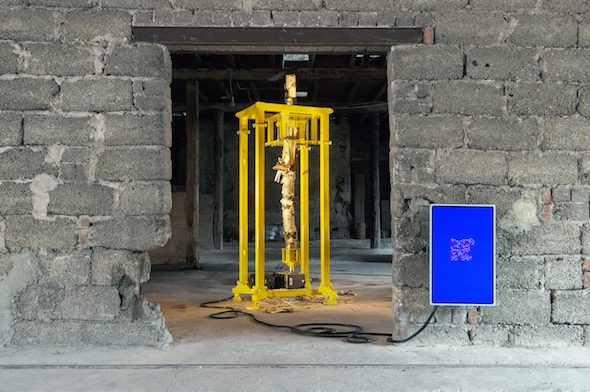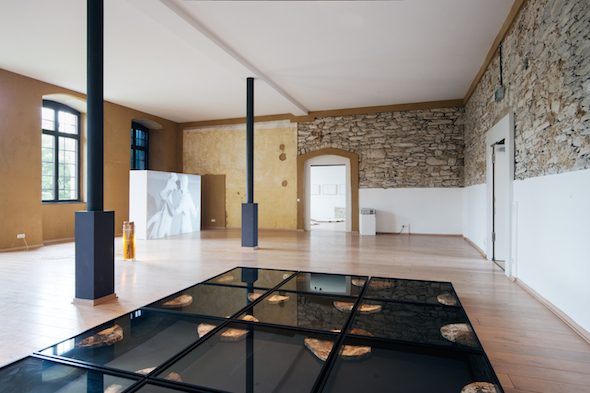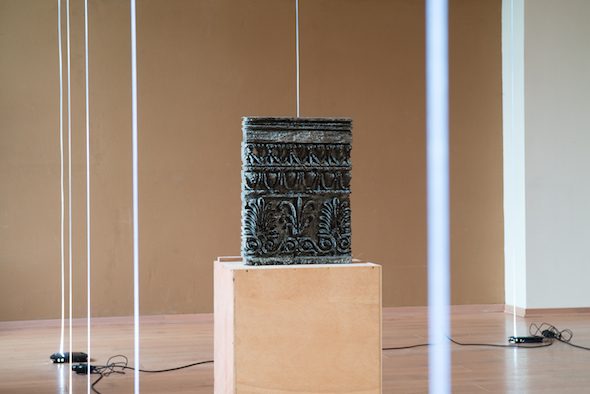Staging integrations of nature and technology, past and present, the group exhibition ‘Hybrid Modus’ curated by Ursula Ströbele and Bas Hendrikx at Skulptur Bredelar explores the evolving relationship between sculpture and its physical surroundings, and the changing notions of tangibility that emerge within an increasingly digital environment. The exhibition itself takes a hybrid approach, tracing developments within the sculptural tradition while employing sculpture as a medium through which to reveal the ways new technologies impact our connections to both natural and built surroundings.

Stian Korntved Ruud &AE: ‘Ludological’, Installation at Skulptur Bredelar // Photo by Sander van Wettum
Interacting with the natural landscape and architecture of the Bredelar Monastery—which dates to the Middle Ages and is enmeshed in an industrial past revolving around wood, glass and metalworking—some of the participating artists have produced site-specific works, drawing on this composite religious and industrial history. As opposed to possessing the monumentality and immobility of traditional sculpture, the works on view communicate change and instability, with time and continual transformation as essential components.

Markus Hoffman: ‘Memory’, Installation at Skulptur Bredelar // Photo by Sander van Wettum
The vitrine display becomes an element of the sculpture itself, presenting the objects within, while merging with them, in Markus Hoffmann‘s ‘Memory’: a living sculptural installation tracing time, growth and transformation. The sculpture comprises a floor-based system of vitrines in a grid formation, encasing sliced portions of tree trunk culled from various locations worldwide. The tree discs—isolated and preserved under glass like scientific specimens—are cut off from a connection to nature, apart from an emergent relationship with spreading fungi cohabiting their new, constructed ecosystem. The grid configuration simultaneously facilitates connection and separation, as the discs are both made whole and severed at each of its intersections. Diverging from a mode of displaying detached, immutable objects within cases that provide views from multiple perspectives, Hoffmann’s glass boxes are flattened, permitting only a view from above, and somewhat distanced, as though peering through the lens of a microscope to observe the changing organisms below. The work references memory, as a process of storing and archiving, on multiple levels: in the rings of a tree trunk as a system for recording time and mapping history; and in the form of the disc, which also signifies a carrier of digital data. These processes of memory are further exposed as inconstant systems susceptible to shifts and lapses over time.
Similarly engaging the grid to display and connect data collected from the earth, Philip Topolovac utilizes methods of casting to produce molds that elude specificity—emerging as amorphous, indeterminate surfaces. Mapping diverse terrains while leaving them unlocatable, Topolovac’s ground molds indicate techniques of reproduction that further distance each from the uniqueness of place that their particular coordinates would suggest. Processes of mapping and categorization are ultimately destabilized, and fixed, specific places are generated as indistinct, replicable templates.
Spiros Hadjidjanos works with digital modes of molding and reproduction in the form of the 3D aluminum print, translating a photograph of an antique relief back into its original three dimensional form. In the process, flat rendering is realized as physical object, while the tactile dimension of the sculptural medium dissipates. Exploring themes of memory, time and documentation of the historic in engagement with the contemporary, Hadjidjanos projects this now intangible sculptural-architectural element into space, mapping its original context (a temple) with pillars that materialize from the light of fiber optic cables. Through collective memory, archival photographs, and regeneration of the past through contemporary technologies this lost temple is not only made visible, but tangible: manifesting a progression from photography’s role in the development of art historical study.

Spiros Hadjidjanos: Installation at Skulptur Bredelar // Photo by Sander van Wettum
The process of molding, in which the material is still malleable and open to change, lingers in the final objects and their display. Reproductive processes of photography and printing meld with the replicability of sculpture through casting molds, mapping new topographies that traverse both digital and material realms, flat surface and physical space, tracing intersections that exist in contemporary life but often remain undetected.
Exhibition
SKULPTUR BREDELAR
Group Show: ‘Hybrid Modus’
Curated by Ursula Ströbele and Bas Hendrikx
Exhibition: May 28–July 31, 2016
Sauerlandstraße 74, 34431 Marsberg, click here for map





















